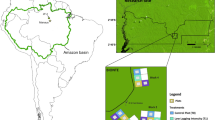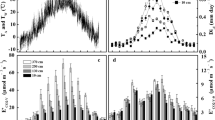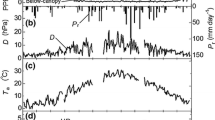Abstract
The stable C isotope composition (δ13C) of CO2 respired by trunks was examined in a mature temperate deciduous oak forest (Quercus petraea). Month-to-month, day-to-day and diurnal, measurements were made to determine the range of variations at different temporal scales. Trunk growth and respiration rates were assessed. Phloem tissue was sampled and was analysed for total organic matter and soluble sugar 13C composition. The CO2 respired by trunk was always enriched in 13C relative to the total organic matter, sometimes by as much as 5‰. The δ13C of respired CO2 exhibited a large seasonal variation (3.3‰), with a relative maximum at the beginning of the growth period. The lowest values occurred in summer when the respiration rates were maximal. After the cessation of radial trunk growth, the respired CO2 δ13C values showed a progressive increase, which was linked to a parallel increase in soluble sugar content in the phloem tissue (R = 0.95; P < 0.01). At the same time, the respiration rates declined. This limited use of the substrate pool might allow the discrimination during respiration to be more strongly expressed. The late-season increase in CO2 δ13C might also be linked to a shift from recently assimilated C to reserves. At the seasonal scale, CO2 δ13C was negatively correlated with air temperature (R = −0.80; P < 0.01). The diurnal variation sometimes reached 3‰, but the range and the pattern depended on the period within the growing season. Contrary to expectations, diurnal variations were maximal in winter and spring when the leaves were missing or not totally functional. By contrast to the seasonal scale, these diurnal variations were not related to air temperature or sugar content. Our study shows that seasonal and diurnal variations of respired 13C exhibited a similar large range but were probably explained by different mechanisms.





Similar content being viewed by others
References
Badeau V, Becker M, Bert D, Dupouey JL, Lebourgeois F, Picard JF (1996) Long-term growth trends of trees: ten years of dendrochronological studies in France. In: Spiecker H, Mielikäinen K, Köhl M, Skovsgaard JP (eds) Growth trends in European forests. Springer, Berlin Heidelberg New York, pp 167–181
Badeck FW, Tcherkez G, Nogues S, Piel C, Ghashghaie J (2005) Post-photosynthetic fractionation of stable carbon istotopes between plant organs-a widespread phenomenon. Rapid Commun Mass Spectrom 19:1381–1391
Baldocchi DD, Bowling DR (2003) Modelling the discrimination of 13CO2 above and within a temperate broad-leaved forest canopy on hourly to seasonal time scale. Plant Cell Environ 26:231–244
Barbaroux C, Bréda N (2002) Contrasting distribution and seasonal dynamics of carbohydrates reserves in stem wood of adult ring porous (sessile oak) and diffuse porous (common beech) trees. Tree Physiol 22(17):1201–1210
Barbour MM, Hunt JE, Dungan RJ, Turnbull MH, Brailsford GW, Farquhar GD, Whitehead D (2005) Variation in the degree of coupling between δ13C of phloem sap and ecosystem respiration in two mature Nothofagus forests. New Phytol 166:497–512
Berninger F, Sonninen E, Aalto T, Lloyd J (2000) Modeling 13C discrimination in tree rings. Global Biogeochem Cycles 23:10–28
Bhupinderpal-Singh, Nordgren A, Ottoson Lofvenius M, Hogberg MN, Mellander PE, Hogberg P (2003) Tree root and soil heterotrophic respiration as revealed by girdling of boreal Scots pine forest: extending observations beyond the first year. Plant Cell Environ 26:1287–1296
Bowling DR, Mc Dowell NG, Bond BJ, Law BE, Ehleringer JR (2002) 13C content of ecosystem respiration is linked to precipitation and vapour pressure deficit. Oecologia 131:113–124
Brugnoli E, Hubick KT, von Caemmerer S, Wong SC, Farquhar GD (1988) Correlation between the carbon isotope discrimination in leaf starch and sugar of C3 plants and the ratio of intercellular and atmospheric pressures of carbon dioxide. Plant Physiol 88:1418–1424
von Caemmerer S, Evans JR (1991) Determination of the average partial pressure of CO2 in chloroplasts from leaves of several C3 plants. Aust J Plant Physiol 18:287–305
Damesin C, Lelarge C (2003) Carbon isotope composition of current-year shoots from Fagus sylvatica in relation to growth, respiration and use of reserves. Plant Cell Environ 26:207–219
Damesin C, Rambal S, Joffre R (1998) Seasonal and annual changes in leaf δ13C in two co-occuring Mediterranean oaks: relations to leaf growth and drought progression. Funct Ecol 12:778–785
Damesin C, Ceschia E, Le Goff N, Ottorini JM, Dufrêne E (2002) Stem and branch respiration of beech: from tree measurements to estimations at the stand level. New Phytol 153:159–172
Damesin C, Barbaroux C, Berveiller D, Lelarge C, Chaves M, Maguas C, Maia R, Pontailler JY (2005) The carbon isotope composition of CO2 respired by trunks: comparison of four sampling methods. Rapid Commun Mass Spectrom 19:369–374
Dhôte JF, Hervé JC (2000) Productivity changes in four sessile oak forests since 1930: a stand-level approach. Ann For Sci 57:651–680
Duranceau M, Ghashghaie J, Badeck F, Deleens E, Cornic G (1999) 13C of CO2 respired in the dark in relation to δ13C of leaf carbohydrates in Phaseolus vulgaris L. under progressive drought. Plant Cell Environ 22:515–524
Duranceau M, Ghashghaie J, Brugnoli E (2001) Carbon isotope discrimination during photosynthesis and dark respiration in intact leaves of Nicotiana sylvestris: comparison between wild type and mitochondrial mutant plants. Aust J Plant Physiol 28:65–71
Ehleringer JR, Bowling DR, Flanagan LB, Fessenden J, Helliker B, Martinelli LA, Ometto JP (2002) Stable isotopes and carbon cycle in forests and grasslands. Plant Biol 4:181–189
Ekblad A, Högberg P (2001) Natural abundance of 13C in CO2 respired from forest soils reveals speed of link between tree photosynthesis and root respiration. Oecologia 127:305–308
Ekblad A, Boström B, Holm A, Comstedt D (2005) Forest soil respiration rate and δ13C is regulated by recent above ground weather conditions. Oecologia 143:136–142
Farquhar G, Richards RA (1984) Isotope composition of plant carbon correlates with water-use efficiency of wheat genotypes. Aust J Plant Physiol 11:539–552
Farquhar GD, O’Leary MH, Berry A (1982) On the relationship between carbon isotope discrimination and the intercellular carbon dioxide concentration in leaves. Aust J Plant Physiol 9:121–137
Farquhar G, Ehleringer JR, Hubick KT (1989) Carbon isotope discrimination and photosynthesis. Annu Rev Plant Physiol Plant Mol Biol 40:503–537
Fessenden J, Ehleringer J (2003) Temporal variation in δ13C of ecosystem respiration in the Pacific Northwest: links to moisture stress. Oecologia 136:129–136
Gessler A, Rennenberg H, Keitel C (2004) Stable isotope composition of organic compounds transported in the phloem of European beech—evaluation of different methods of phloem sap collection and assessment of gradients in carbon isotope composition during leaf to stem transport. Plant Biol 6:721–729
Ghashghaie J, Duranceau M, Badeck FW, Cornic G, Adeline MT, Deleens E (2001) δ13C of CO2 respired in the dark in relation to δ13C of leaf metabolites: comparisons between Nicotiana sylvestris and Helianthus annuus under drought. Plant Cell Environ 24:505–515
Hari P, Nyrgen P, Korpilahti E (1991) Internal circulation of carbon within a tree. Can J For Res 21(4):514–515
Helle G, Schleser GH (2004) Beyond CO2-fixation by Rubisco—an interpretation of 13C/12C variations in tree rings from novel intra-seasonal studies on broad-leaf trees. Plant Cell Environ 27(3):367–380
Hymus GJ, Maseyk K, Valentini R, Yakir D (2005) Large daily variation in 13C-enrichment of leaf-respired CO2 in two Quercus forest canopies. New Phytol 167:377–384
Keeling CD (1958) The concentration and isotopic abundances of atmospheric carbon dioxide in rural areas. Geochim Cosmochim Acta 13:322–334
Keitel C, Adams M.A., Holst T, Matzarakis A, Mayer H, Rennenberg H, Gessler A (2003) Carbon and oxygen isotope composition of organic compounds in the phloem sap provides a short-term measure for stomatal conductance of European beech (Fagus sylvatica L.). Plant Cell Environ 26:1157–1168
Klumpp K, Schäufele R, Lötscher M, Lattanzi FA, Feneis W, Schnyder H (2005) C-isotope composition of CO2 respired by shoots and roots: fractionation during dark respiration? Plant Cell Environ 28:241–250
Knohl A, Werner RA, Brand WA, Buchmann N (2005) Short-term variations in δ13C of ecosystem respiration reveals link between assimilation and respiration in a deciduous forest. Oecologia 142:70–82
Lavigne M, Ryan MG (1997) Growth and maintenance respiration rates of aspen, black spruce and jack pine stems at northern and southern BOREAS sites. Tree Physiol 17:543–551
Martin TA, Teskey RO, Dougherty PM (1994) Movement of respiratory CO2 in stems of Loblolly-Pine (Pinus taeda L.) seedlings. Tree Physiol 14(5):481–495
Meir EP, Allen SJ, Jarvis PG (1999) The effect of aqueous transport of CO2 in xylem sap on gas exchange in woody plants. Tree Physiol 19(1):53–58
Mortazavi B, Chanton JP, Prater JL, Oishi AC, Oren R, Katul G (2005) Temporal variability in 13C of respired CO2 in a pine and a hardwood forest subject to similar climatic conditions. Oecologia 142:57–69
O’Leary MH (1981) Carbon isotope fractionation in plants. Phytochemistry 20:553–567
Pontailler JY (1990) A cheap quantum sensor using a gallium arsenide photodiode. Funct Ecol 4:591–596
Poorter H, Farquhar GD (1994) Transpiration, intercellular carbon dioxide concentration and carbon-isotope discrimination of 24 wild species differing in relative growth rate. Annu Rev Plant Physiol 21:507–516
Prater JL, Mortazavi B, Chanton JP (2005) Diurnal variation of the δ13C of pine needle respired CO2 evolved in darkness. Plant Cell Environ. DOI 10.1111/j.1365–3040.2005.01413.x
Ryan MG, Hubbard RM, Pongracic S, Raison RJ, McMurties RE (1996) Foliage, fine-root, woody-tissue and stand respiration in Pinus radiata in relation to nitrogen status. Tree Physiol 16:33–343
Saugier B, Roy J, Mooney HA (2001) Estimations of global terrestrial productivity: converging toward a single number? In: Saugier B, Roy J, Mooney HA (eds) Terrestrial global productivity. Physiological ecology series. Academic Press, San Diego, Calif., pp 543–557
Scartazza A, Mata C, Matteucci G, Yakir D, Moscatello S, Brugnoli E (2004) Comparisons of δ13C of photosynthetic products and ecosyste respiratory CO2 and their responses to seasonal climate variability. Oecologia 140:340–351
Tcherkez G, Nogues S, Bleton J, Cornic G, Badeck F, Ghashghaie J (2003) Metabolic origin of carbon isotope composition of leaf dark-respired CO2 in French bean. Plant Physiol 131(1):237–244
Tcherkez G, Cornic G, Bligny R, Gout E, Ghashghaie J (2005) In vivo respiratory metabolism of illuminated leaves. Plant Physiol 138:1596–1606
Teskey RO, McGuire MA (2002) Carbon dioxide transport in xylem causes errors in estimation of rates of respiration in stems and branches of trees. Plant Cell Environ 25:1571–1577
Thimonier A, Dupouey JL, Bost F, Becker M (1994) Simultaneous eutrophication and acidification of a forest ecosystem in North-East France. New Phytol 126:533–539
Xu CY, Lin GH, Griffin KL, Sambrotto RN (2004) Leaf respiratory CO2 is 13C enriched relative to leaf organic components in five species of C3 plants. New Phytol 163:499–505
Acknowledgements
Many thanks to Alice Michelot and Amandine Hansart for their assistance in the field and laboratory work. The authors are grateful to the Office National des Forêts, especially Michel Bénard, for facilitating the experimental work in the Barbeau forest. The meteorological data (precipitation, humidity) of Fig. 1 were provided by Météo-France (Melun, France). We acknowledge Elizabeth Gerson and International Science Editing for correcting the English language of the manuscript. This research was financed by the French projects: Ministère délégué à la recherche-ACI Jeunes Chercheurs (no. JC10009) and Programme National ACI/FNS ECCO, PNBC (convention no. 0429 FNS), and the ESE laboratory supported by the University Paris XI and CNRS. We are grateful to five anonymous reviewers for useful suggestions, which enabled the authors to improve the clarity of the manuscript. The study complies with current French law.
Author information
Authors and Affiliations
Corresponding author
Additional information
Communicated by Nina Buchmann.
Rights and permissions
About this article
Cite this article
Maunoury, F., Berveiller, D., Lelarge, C. et al. Seasonal, daily and diurnal variations in the stable carbon isotope composition of carbon dioxide respired by tree trunks in a deciduous oak forest. Oecologia 151, 268–279 (2007). https://doi.org/10.1007/s00442-006-0592-z
Received:
Accepted:
Published:
Issue Date:
DOI: https://doi.org/10.1007/s00442-006-0592-z




